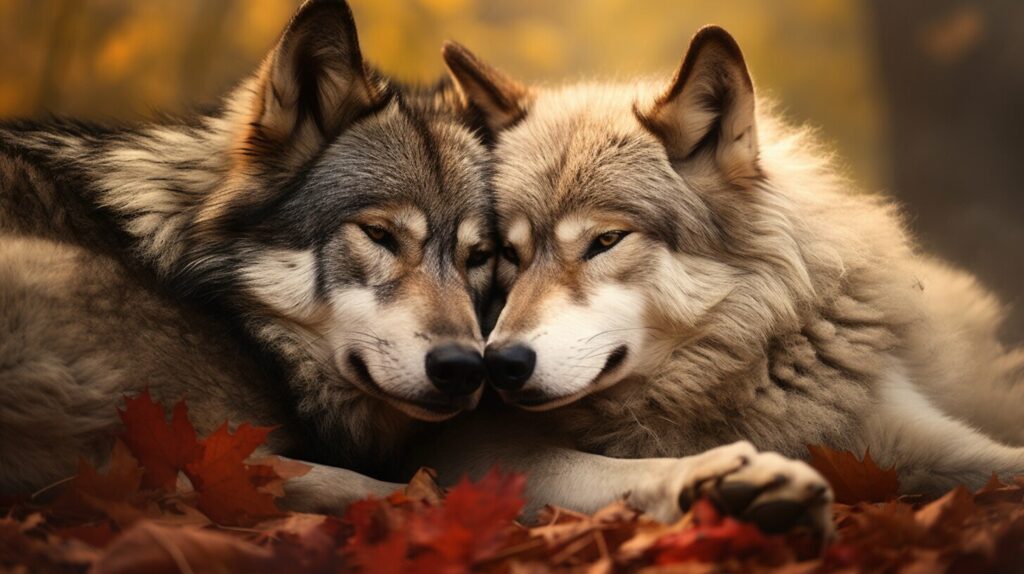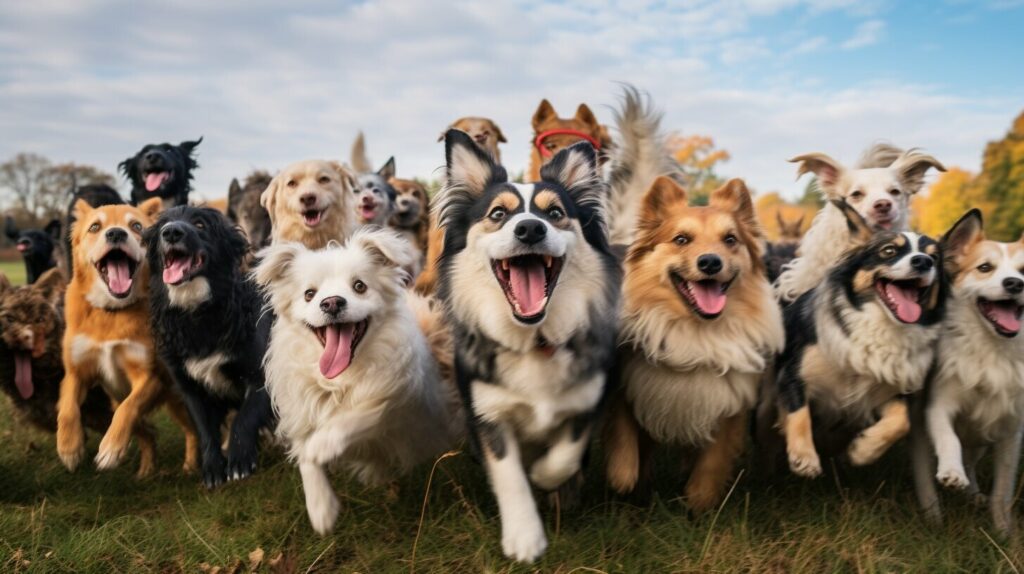Have you ever wondered about the connection between dogs and wolves? These two species share a fascinating history that stretches back thousands of years. Dogs are what we call a subspecies of wolves, which means they are closely related genetically. Some dog breeds, commonly known as “wolf dogs,” even closely resemble their wild counterparts in appearance and behavior. Let’s dive in and explore the culture, history, and science behind the mystical bonds between dogs and wolves.
Key Takeaways:
- Dogs and wolves share a fascinating and complex history.
- Some dog breeds closely resemble wolves in appearance and behavior and are commonly known as “wolf dogs.
- Understanding the relationship between dogs and wolves is important for their conservation and our understanding of their behavior.
The History of Dogs and Wolves
Before exploring the intriguing relationship between dogs and wolves, it’s essential to understand their respective histories. Both dogs and wolves belong to the Canidae family, which also includes other species like foxes and coyotes. Wolves are the ancestors of domesticated dogs, having diverged from a common ancestor around 40,000 years ago.
The key difference between dogs and wolves is their level of domestication. Dogs have been selectively bred for thousands of years, resulting in a wide variety of breeds that range in size, shape, and temperament. In contrast, wolves are wild animals that have never been fully domesticated. While they share many physical and behavioral traits with dogs, they retain their natural instincts and are not suited for domestic life.
Some similarities between dogs and wolves can be observed in their social structures. Both species live in packs led by a dominant alpha male and female, although dog packs are more loosely organized. Dogs and wolves also use similar body language and vocalizations to communicate with one another and express emotions such as fear, aggression, and submission.
Wolf Dogs: The Intersection of Domesticity and Wildness
If you are fascinated by wolves and their captivating features, you might have considered owning a dog breed related to wolves, also known as a wolf dog. These breeds, such as the Czechoslovakian Wolfdog and the Tamaskan, resemble their wild ancestors to varying degrees.
It is important to note that wolf dogs are not ordinary pets. They are hybrid animals resulting from the breeding of a wolf and a domestic dog. The offspring of such breeding is a complex mixture of domestic and wild traits that makes it challenging to predict their behavior accurately. Some owners describe them as loyal and affectionate, while others comment on their independent and unpredictable nature.
The question of whether dogs can be domesticated like wolves is an ongoing debate among experts. While both species share common ancestry, they have followed separate evolutionary paths for thousands of years. Domestic dogs have evolved to live alongside humans and have lost some of their wild instincts as a result. On the other hand, wolves are still highly territorial, aggressive, and predatory, making them challenging to domesticate.
Due to the complex genetics and unpredictable behaviors of wolf dogs, owning one requires a high level of commitment and expertise. They have specific physical and emotional needs that require proper attention and training. Furthermore, laws regulating wolf dog ownership vary by state, with some outright bans on owning them as pets.
In conclusion, owning a wolf dog is not for everyone. It is crucial to research and educate yourself about the breed before making a decision. While wolf dogs can be loyal and affectionate companions, they require an experienced and responsible owner who can meet their specific needs. If you are genuinely interested in this breed, consider reaching out to experts for guidance and support.
Wolf-Like Dog Breeds: A Closer Look
There are several dog breeds that closely resemble wolves in appearance and behavior. These breeds have become increasingly popular among dog lovers and enthusiasts who are intrigued by their resemblance to their wild ancestors.
| Breed | Physical Traits | Temperament |
|---|---|---|
| Siberian Husky | Thick double coat, almond-shaped eyes, erect ears, well-muscled body | Friendly, sociable, energetic, independent |
| Alaskan Malamute | Thick double coat, broad head, erect ears, well-muscled body | Loyal, affectionate, strong-willed, independent |
| Czechoslovakian Wolfdog | Thick coat, wolf-like head, lean body, erect ears | Loyal, protective, energetic, independent |
These breeds share many physical characteristics with wolves, including thick double coats, almond-shaped eyes, and erect ears. They are also known for their high energy levels and independent nature, which can make them challenging pets for inexperienced owners.
It’s important to note that even though these breeds are often referred to as “wolf dogs,” they are not actually hybrids of dogs and wolves. Rather, they are domestic dogs that have been selectively bred for their wolf-like qualities. As such, they do not possess the same wild traits and behaviors as their wolf ancestors.
When considering a wolf-like dog breed, it’s important to take into account their specific physical and temperamental characteristics, as well as the challenges that come with owning such a breed. Proper training and socialization are essential for ensuring a happy and healthy relationship between you and your furry companion.
Training and Living with Wolf Dogs
If you’re considering owning a wolf dog, it’s important to understand the unique challenges involved in training and living with them. These animals require specialized care and attention to ensure they can thrive in a domestic environment.
Training Wolf-Like Dogs: Wolf dogs have a strong instinct to hunt and roam, making it crucial to establish boundaries and rules from an early age. Consistent and positive reinforcement training is essential to ensure your wolf dog listens and obeys commands. Proficient trainers are recommended to help the dog respond to basic commands like “sit,” “stay,” and “come.”
Living with a Wolf Dog: A wolf dog requires a lot of space and exercise to stay happy and healthy. It’s important to have a yard or an enclosed space where the dog can run and expend excess energy. It’s also necessary to provide a consistent routine and plenty of socialization opportunities to help the dog bond with humans and other animals.
A wolf dog can make a great companion, but it’s crucial to understand that they are not like regular dogs. These animals are a combination of domestic and wild characteristics, which means they require the right environment, training, and care to live a happy and healthy life.
Canine Companionship: Wolves and Humans
Humans have been fascinated by wolves for centuries, and their relationship with these majestic animals has evolved over time. While wolves were once feared and hunted, they have become symbols of strength, loyalty, and wisdom in many cultures. The bond between wolves and humans has inspired stories, artwork, and even scientific research.
One of the most interesting aspects of this bond is the remarkable similarities between wolves and dogs. Both are intelligent, social animals with complex social structures and communication systems. In fact, dogs are believed to have descended from wolves, and they still share many genetic traits and behaviors.
Studies have shown that wolves and dogs have similar body language and vocalizations, and they use these cues to communicate with each other and with humans. For example, both species use facial expressions and body postures to convey emotions like fear, aggression, and playfulness.
Additionally, both wolves and dogs form close bonds with their pack or family members. They are highly social animals that rely on each other for survival and emotional support. This is why it’s so important for pet owners to provide their dogs with plenty of socialization and companionship.
While wolves and dogs are undeniably different in many ways, their shared characteristics have helped humans develop a deep appreciation for both species. Whether it’s observing a wild wolf pack from a distance or playing fetch with your furry best friend, our connection with these animals is something truly special.
Conservation and Wolf Conservation Dogs
The world has witnessed the decline of wolf populations over the years, with many efforts to conserve these iconic animals. One such effort is the use of wolf conservation dogs, which have been instrumental in protecting wolf populations in their natural habitats. These dogs are highly trained to assist in research, tracking, and coexistence strategies.
Wolf conservation dogs work closely with researchers and conservationists to locate and study wild wolf packs. They are trained to detect and alert their human handlers to the presence of wolves, as well as other animals, such as cougars and bears. This is essential in protecting both the wolves and the surrounding ecosystem, as it helps researchers better understand the behavior and movements of wolves in the wild.
Wolf conservation dogs also play a crucial role in mitigating conflicts between wolves and humans. They are trained to help identify and track individual wolves, which aids in reducing livestock depredation and other potential conflicts. These dogs also assist with non-lethal deterrent strategies, such as hazing, which helps to keep wolves away from areas where they may come into conflict with humans.
Additionally, wolf conservation dogs have been used in pioneering studies that explore the communication and social behavior of wolves. These studies help researchers learn more about the fascinating world of wolves and their complex social structure.
Overall, the use of wolf conservation dogs is a valuable tool in preserving the future of wolves and their ecosystems. These dogs demonstrate the unique and mutually beneficial relationship between dogs and wolves, highlighting the importance of understanding and respecting each species.
Wolves in Pop Culture: Mythology and Symbolism
Wolves have long captured our imaginations and held a special place in our cultural psyche. From mythological creatures to literary characters, wolves have played a prominent role in human storytelling and symbolism.
One of the most famous wolf myths involves Romulus and Remus, the founders of Rome, who were suckled and raised by a she-wolf. In Native American mythology, the wolf is often seen as a symbol of strength, loyalty, and intelligence. In Norse mythology, Odin was accompanied by two wolves, Geri and Freki, who represented his constant companionship and loyalty.
The wolf has also been a popular character in literature and film, often portrayed as cunning and mysterious. In J.K. Rowling’s “Harry Potter” series, Remus Lupin is a werewolf who teaches Defense Against the Dark Arts. In the classic fairy tale “Little Red Riding Hood,” the wolf is seen as a villain who preys on innocent victims.
Despite the negative connotations associated with wolves in some cultural contexts, they have also been revered as symbols of strength, freedom, and resilience. In recent years, the wolf has become a popular motif in fashion and design, with their rugged and wild aesthetics appealing to a wide audience.
The popularity of wolf-like dog breeds, such as the Siberian Husky and Alaskan Malamute, has only further cemented the wolf’s cultural significance. People are drawn to these breeds for their physical resemblance to wolves and their perceived traits of loyalty and strength.
Overall, the wolf’s symbolism and mythology have endured through centuries, evolving to reflect the ever-changing attitudes and beliefs of society. Whether they are viewed as fierce predators or noble creatures, wolves continue to captivate and inspire us with their mystique and power.
Conclusion
As you can see, the relationship between dogs and wolves is a complex and fascinating one. Despite their shared ancestry, dogs and wolves have developed distinct physical and behavioral differences over time. However, the allure of wolf-like dogs remains strong, with many people drawn to breeds that resemble their wild counterparts.
While owning a wolf hybrid can present challenges and ethical considerations, there are also many dog breeds that offer the same physical traits without the added complexity of hybridization. It’s important to carefully research and understand the specific needs and requirements of any dog before bringing them into your home.
Ultimately, the bond between wolves and humans serves as a reminder of the intricate connections between all species and the importance of conservation efforts to protect and preserve them. As we continue to learn more about these majestic creatures, we can deepen our appreciation for their place in our world.
FAQ
Q: What are some dog breeds related to wolves?
A: Some dog breeds that have wolf-like features include the Siberian Husky, Alaskan Malamute, and Czechoslovakian Wolfdog.
Q: Can dogs be domesticated like wolves?
A: Dogs have been domesticated for thousands of years, while wolves remain wild animals. However, there are controversial cases of hybridization between dogs and wolves.
Q: What are the challenges of owning a wolf hybrid?
A: Owning a wolf hybrid can be challenging due to their unique needs, including a high prey drive, potential aggression, and specific socialization requirements.
Q: What should I consider before getting a wolf-like dog breed?
A: Before getting a wolf-like dog breed, you should consider their exercise needs, grooming requirements, and the level of dedication and commitment required to meet their specific needs.
Q: How can I train a wolf-like dog?
A: Training a wolf-like dog requires consistency, positive reinforcement, and a deep understanding of their natural instincts. Professional training and socialization are highly recommended.
Q: Are there similarities between dogs and wolves?
A: Yes, dogs and wolves share a common ancestry and have similar social structures and communication patterns.
Q: What role do dogs play in wolf conservation?
A: Dogs play a vital role in wolf conservation efforts, contributing to research, tracking, and coexistence strategies. Wolf conservation dogs are trained to work alongside researchers in the field.
Q: What is the symbolism associated with wolves?
A: Wolves are often associated with loyalty, strength, and intelligence in popular culture and mythology. They symbolize the wild and untamed spirit.
Note: The FAQ section can be customized and expanded based on the specific questions and concerns that readers may have about the topic.



